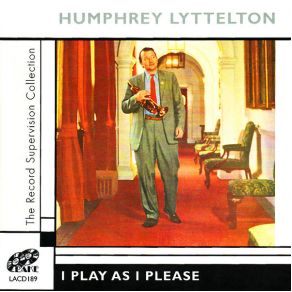I Play As I Please
Download links and information about I Play As I Please by Humphrey Lyttelton. This album was released in 1957 and it belongs to Jazz genres. It contains 13 tracks with total duration of 51:16 minutes.

|
|
|---|---|
| Artist: | Humphrey Lyttelton |
| Release date: | 1957 |
| Genre: | Jazz |
| Tracks: | 13 |
| Duration: | 51:16 |
| Buy it NOW at: | |
| Buy on iTunes $9.99 | |
| Buy on Amazon $6.99 | |
| Buy on iTunes $7.99 | |
| Buy on Songswave €1.13 | |
Tracks
[Edit]| No. | Title | Length |
|---|---|---|
| 1. | Dixie Theme | 3:01 |
| 2. | Blues At Dawn | 2:44 |
| 3. | Skid Row | 6:45 |
| 4. | Manhattan | 3:14 |
| 5. | La Paloma | 3:09 |
| 6. | Going Out the Back Way | 7:08 |
| 7. | Mezzrow | 4:15 |
| 8. | Singing the Blues | 3:09 |
| 9. | Bodega | 2:44 |
| 10. | Looking for Turner | 6:50 |
| 11. | Sweethearts On Parade | 3:17 |
| 12. | Blues In the Afternoon | 2:49 |
| 13. | Buona Sera | 2:11 |
Details
[Edit]Topped and tailed by four bonus tracks, this is an otherwise straightforward (and certainly long-awaited) reissue of Humphrey Lyttelton's best-known and most all-pervasively influential album, the 1957 set that he titled, fittingly, after the first volume of his own autobiography. Widely regarded among the most adventurous of all the players bound up in the British trad boom of the mid- to late '50s, Lyttelton had already broken any number of seemingly inviolate rules by the time he teamed with producer Denis Preston to cut this set — including the addition of a saxophone and the omission of the banjo. Now it was time to push even further. In terms of numerical strength, three bands appear on this album — the seven-piece Humphrey Lyttelton Band, an expanded 12-man big band, and the so-called Humphrey Lyttelton Paseo Band, a nine-piece that eschewed horns for flutes, then added a riot of percussion to the mix. It's a heady blend that had traditionalists wringing their hands in despair when the album first appeared, but time (and, of course, the eventual acceptance of many of the ideas Lyttelton first posited) readily vindicates the album's audacity. For collectors, meanwhile, the set is bolstered by both sides of two singles recorded by the regular Lyttelton Band around the same time as I Play As I Please came together, the self-explanatory "Dixie Theme" and the sultry "Blues in the Afternoon."